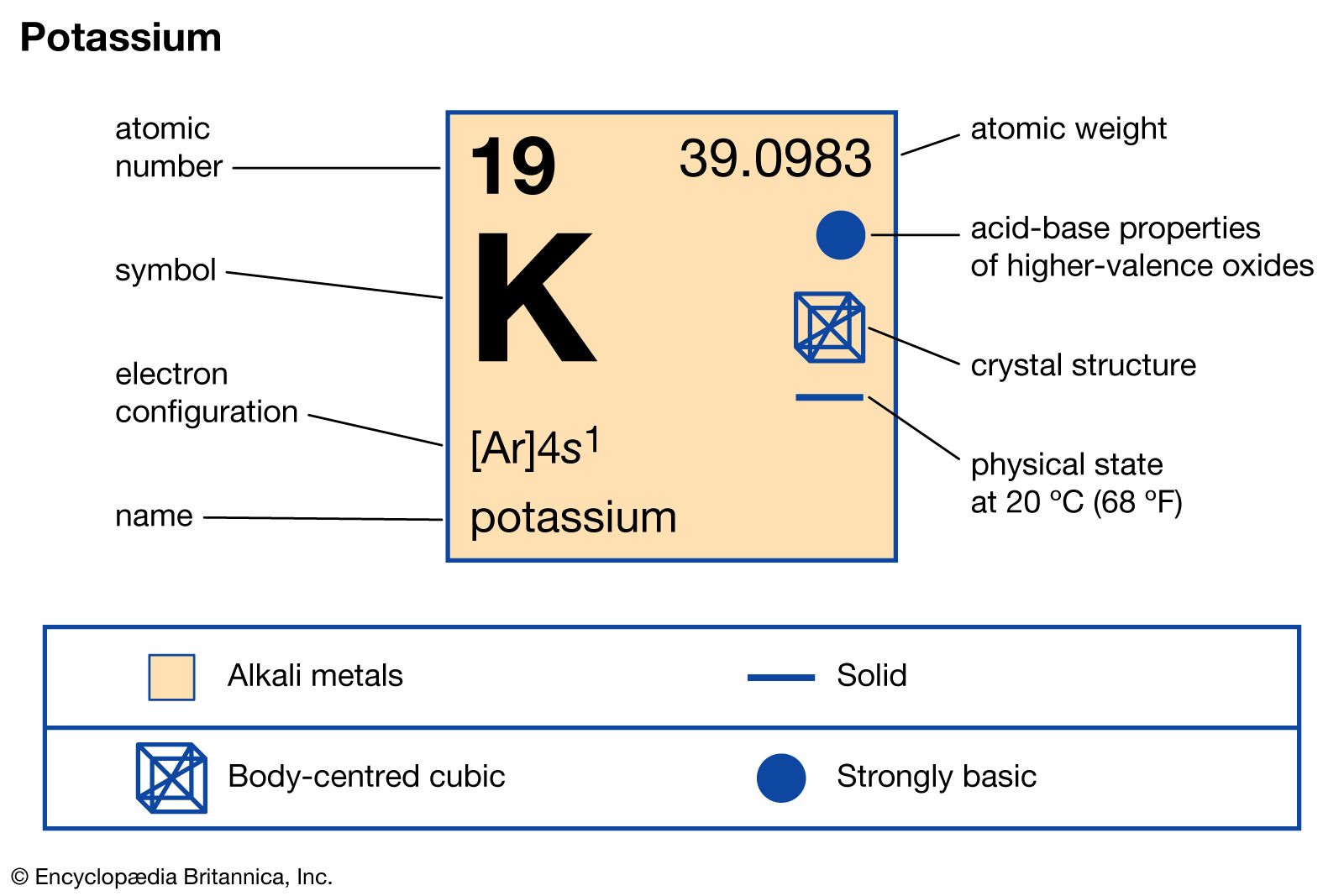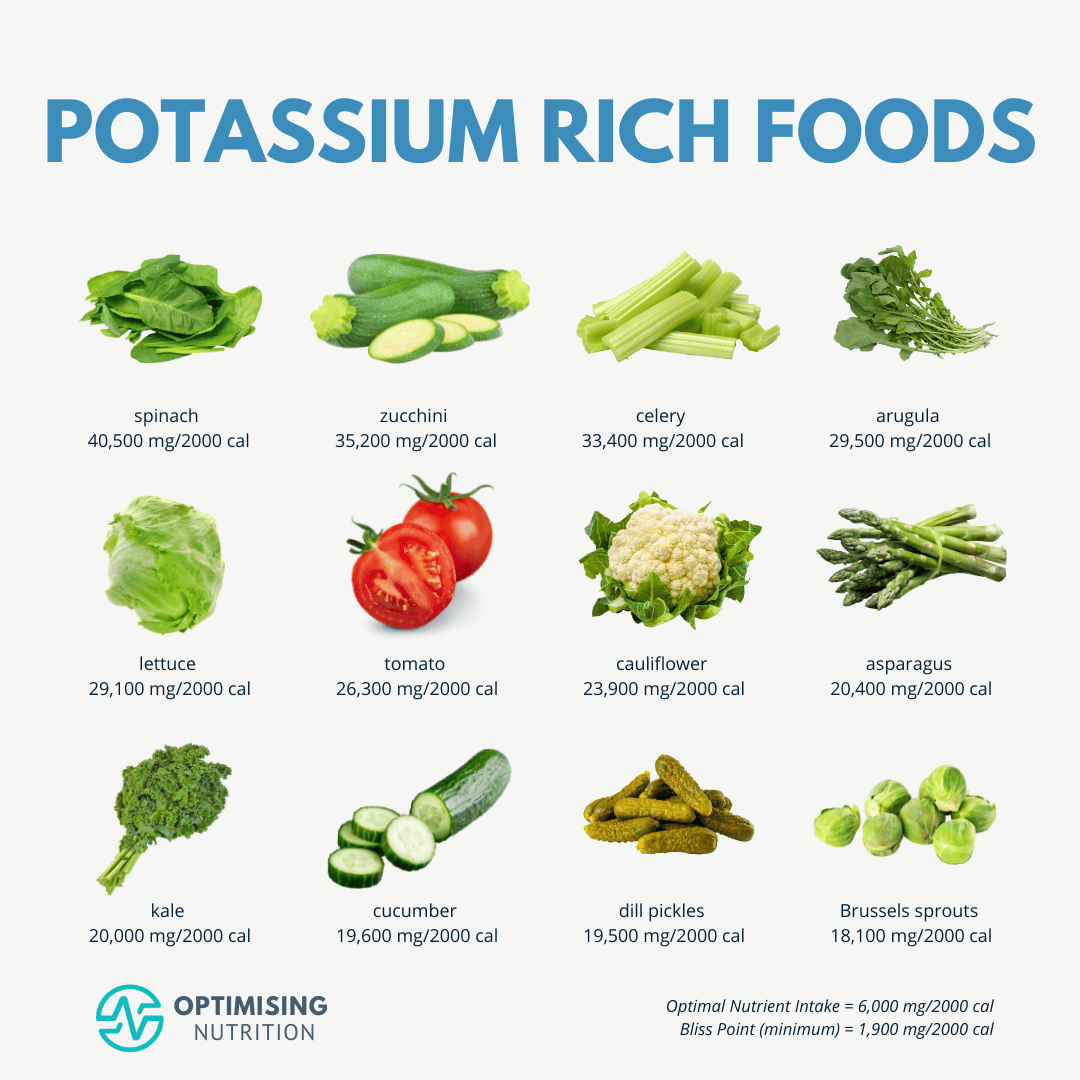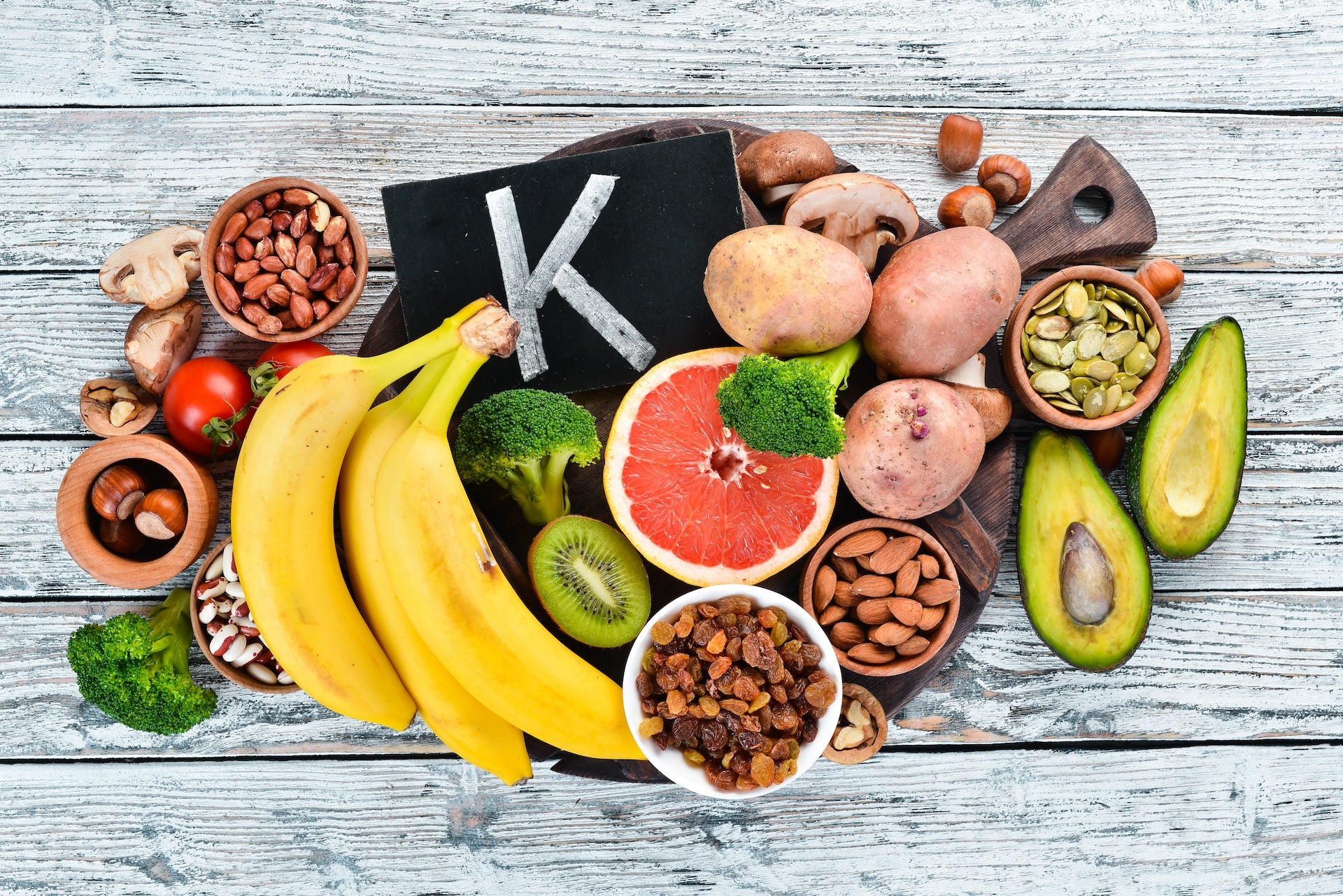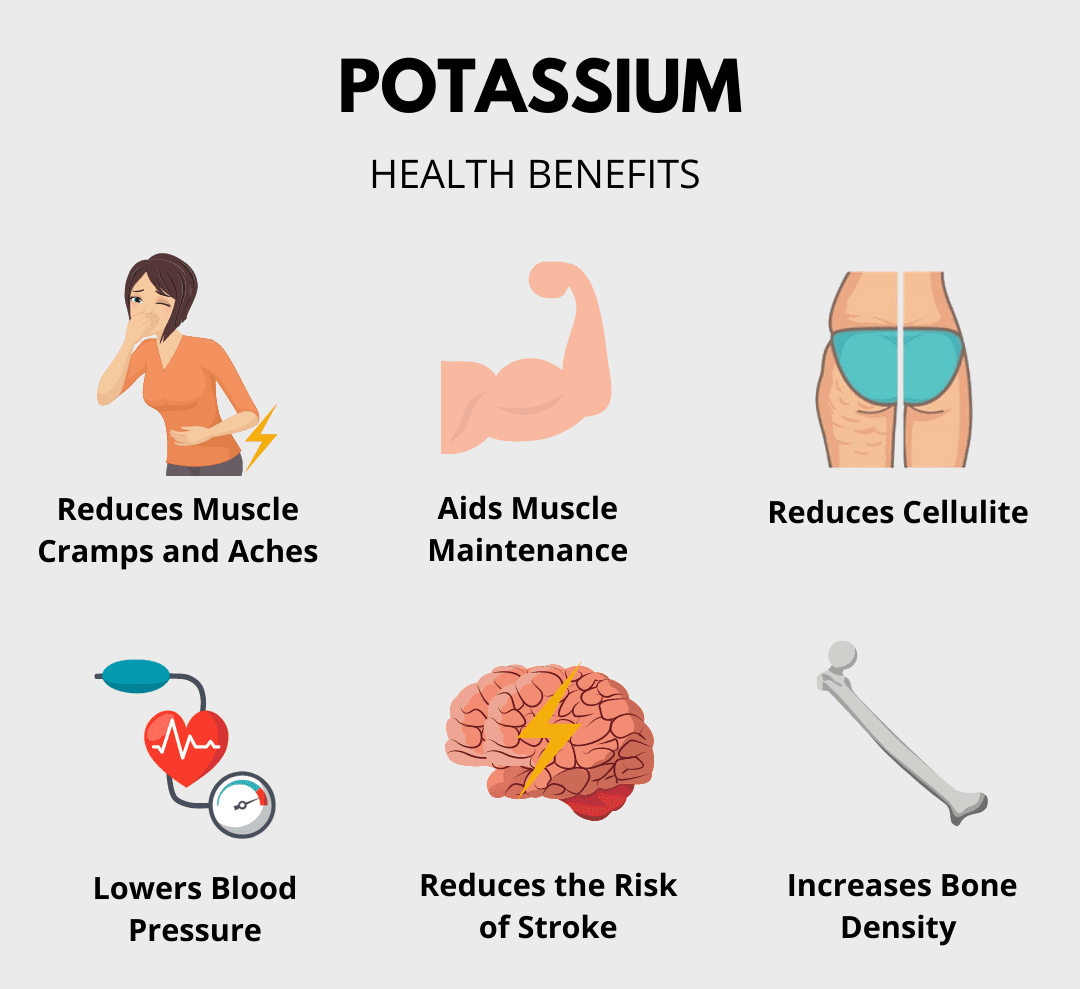Introduction to Potassium

Source: britannica.com
What is Potassium?
Potassium is a vital mineral and electrolyte that plays numerous crucial roles in maintaining your body’s proper functioning. Found naturally in many foods, particularly vegetables, potassium is classified as an essential nutrient because your body cannot manufacture it on its own. [#1]
At its core, potassium is a positively charged ion (K+) that works alongside other electrolytes like sodium, calcium, and magnesium to regulate various bodily processes. This mineral exists within every cell of your body, with about 98% of it found inside your cells and the remaining 2% in your blood plasma and other bodily fluids.
Why You Need Potassium
Potassium isn’t just another item on the nutritional checklist—it’s absolutely fundamental for health and wellbeing. [#2] This mighty mineral contributes to several vital functions:
- Nerve signal transmission throughout your body
- Muscle contraction, including your heart muscle
- Regulation of fluid balance
- Maintenance of healthy blood pressure levels
- Support for kidney function
- Carbohydrate metabolism and protein synthesis
Without adequate potassium, these systems begin to falter. Your muscles might cramp or feel weak, your heart rhythm could become irregular, and your blood pressure might rise. That’s why incorporating potassium-rich vegetables into your daily meals isn’t just beneficial—it’s necessary.
How Much Potassium Do You Need?
According to current dietary guidelines, adults should aim for approximately 2,600-3,400 mg of potassium daily. The specific recommendation varies based on age, sex, and life stage:
- Adult men: 3,400 mg per day
- Adult women: 2,600 mg per day
- Pregnant women: 2,900 mg per day
- Breastfeeding women: 2,800 mg per day
Most people don’t consume enough potassium through their diet. The average intake hovers around 2,000 mg daily—significantly below the recommended amounts. This gap represents an opportunity to improve your health by consciously including more potassium-rich vegetables in your meals.
Potassium’s Role in the Body
The importance of potassium becomes clear when we examine its specific functions in greater detail. This mineral works in a delicate balance with sodium to maintain proper fluid levels inside and outside your cells—a process known as osmotic pressure regulation.
Your nervous system relies heavily on potassium for transmitting electrical impulses. Every time you move a muscle, think a thought, or feel a sensation, potassium ions are flowing across cell membranes, enabling these signals to travel.
For your cardiovascular system, potassium helps relax blood vessel walls, promoting healthy blood flow and reducing strain on your heart. This explains why diets rich in potassium are frequently associated with lower blood pressure and reduced risk of stroke.
Your skeletal system also benefits from adequate potassium intake. Research suggests this mineral helps preserve bone mineral density by reducing calcium loss through urine, potentially protecting against osteoporosis as you age.
Understanding these fundamental aspects of potassium helps highlight why focusing on potassium-rich vegetables isn’t just about following a dietary trend—it’s about providing your body with a critical component it needs for optimal performance and long-term health.
High Potassium Vegetables and Foods

Source: optimisingnutrition.com
List of High-Potassium Vegetables
When it comes to boosting your potassium intake, vegetables offer some of the most concentrated and bioavailable sources of this essential mineral. Let’s explore the top contenders that can help you reach your daily potassium goals.
Leafy greens stand out as potassium powerhouses. Cooked Swiss chard delivers an impressive 20% of your daily value (DV) for potassium in just one cup. Similarly, beet greens pack a significant potassium punch, making them an excellent addition to soups and sautés. [#3] For those who prefer spinach, a cup of the cooked leafy green provides approximately 167 milligrams of potassium. [#4]
Root vegetables are another fantastic source of this vital mineral. A medium-baked potato contains about 940 milligrams of potassium, making it one of the most potent vegetable sources available. Sweet potatoes aren’t far behind—a medium sweet potato provides around 541 milligrams, while a cup of mashed sweet potato offers 16% of your daily potassium needs.
Don’t overlook these additional potassium-rich vegetables:
- Cooked yams: 19% of the DV per cup
- Boiled beets: 11% of the DV per cup
- Winter squash: 640 milligrams per cooked cup
- Parsnips: High in potassium and fiber
- Mushrooms: A versatile potassium source for many dishes
Other High Potassium Foods
While vegetables are stellar sources of potassium, several other food categories can help diversify your intake of this crucial mineral.
Legumes rank among the top potassium contributors. White beans contain 21% of the DV for potassium in a single cup, making them an exceptional choice. Soybeans are equally impressive, with one cup of cooked soybeans delivering nearly 890 milligrams. For a convenient option, try edamame (young soybeans), which provides around 676 milligrams per cup. Lima beans also deserve mention as potassium-rich legumes worth incorporating into your meals.
Fruits complement vegetables in a potassium-rich diet. Avocados stand out as a particularly valuable source, offering potassium alongside healthy fats. A whole pomegranate provides 14% of your daily potassium needs, making it both a delicious and nutritious choice. Melons like cantaloupe and honeydew, along with nectarines, also contribute meaningful amounts of this mineral.
Tomato products deserve special attention for their concentrated potassium content:
- Tomato paste: 670 milligrams per quarter-cup
- Tomato sauce: 728 milligrams per cup
- Tomato juice: High in potassium and other nutrients
Even blackstrap molasses makes the list as a surprising potassium source, offering a mineral-rich alternative to refined sweeteners.
Nutrient Density and Potassium
When evaluating potassium sources, consider not just the absolute amount of the mineral but also the overall nutrient profile of the food. The concept of nutrient density—the ratio of beneficial nutrients to calories—becomes particularly relevant.
Many potassium-rich vegetables and legumes excel in this regard. They deliver substantial potassium alongside fiber, vitamins, minerals, and phytonutrients, all while keeping calorie counts relatively low. This makes them efficient choices for optimizing your overall nutrition.
For instance, leafy greens like Swiss chard and spinach provide potassium along with iron, magnesium, vitamins A, C, and K, and various antioxidants—all with minimal calories. Similarly, sweet potatoes offer potassium plus beta-carotene, vitamin C, and fiber in a satisfying package.
Creating meals that combine multiple potassium sources can help you reach your daily target while enjoying diverse flavors and textures. Consider a hearty vegetable stew with white beans, tomatoes, and sweet potatoes, or a nutrient-packed salad featuring spinach, avocado, and edamame.
By prioritizing these nutrient-dense, potassium-rich foods, you’re not just addressing a single mineral need—you’re supporting your overall health with a spectrum of beneficial compounds that work synergistically in your body.
Understanding Potassium in Your Diet

Source: nutritionsource.hsph
Reading Food Labels for Potassium
Navigating food labels can significantly improve your ability to track potassium intake. Since 2020, the FDA has required potassium content to be listed on nutrition facts panels, making it easier to monitor your consumption of this vital mineral. When examining labels, look for the potassium amount listed in milligrams (mg) and the corresponding percentage of Daily Value (%DV).
A quick reference guide for potassium content on labels:
- Low: Less than 140 mg per serving
- Good source: 10-19% of the Daily Value
- Excellent source: 20% or more of the Daily Value
Remember that processed foods often contain added sodium but minimal potassium, creating an imbalance that may affect blood pressure regulation. Prioritizing whole foods with naturally occurring potassium helps maintain a healthier sodium-potassium ratio.
When You Need to Avoid Potassium
While most people benefit from increasing their potassium intake, certain medical conditions require careful monitoring or restriction of this mineral. Individuals with chronic kidney disease (CKD) often need to limit potassium consumption because their kidneys cannot efficiently remove excess potassium from the bloodstream.
Other situations that may necessitate potassium restriction include:
- Taking certain medications, particularly some blood pressure medications, NSAIDs, or potassium-sparing diuretics
- Addison’s disease
- Type 1 diabetes in some cases
- Recovery from severe burns or crush injuries
If you have any of these conditions, work closely with your healthcare provider to determine appropriate potassium levels for your specific situation. Never start a high-potassium diet without medical guidance if you have kidney problems or take medications that affect potassium balance.
Low-Potassium Foods
For those who need to restrict potassium, focusing on low-potassium alternatives can help maintain a balanced diet while managing mineral levels. Several vegetables and fruits contain lower amounts of potassium but still offer valuable nutrients.
Low-potassium vegetables include:
- Green beans
- Cabbage
- Carrots
- Cucumber
- Eggplant
- Lettuce
- Onions
- Peppers
Fruits with lower potassium content include apples, berries, grapes, pineapple, and tangerines. Grains like rice, pasta, and bread also typically contain less potassium, making them suitable options for low-potassium diets.
A food preparation technique called leaching can reduce the potassium content in some high-potassium vegetables. This process involves cutting the vegetable into small pieces, soaking in warm water for several hours, then boiling in fresh water. While this method diminishes some nutritional value, it allows greater dietary variety for those on potassium restrictions.
Potassium Supplements and Safety
Most healthy individuals should aim to get their potassium from food sources rather than supplements. The FDA recommends an average of 4,700 milligrams of potassium per day, yet most Americans get about half of their daily potassium requirement.
Despite this common shortfall, over-the-counter potassium supplements are typically limited to small doses (around 99 mg per serving) due to safety concerns. Higher-dose supplements require a prescription and medical supervision because excessive potassium can cause serious health problems, including heart arrhythmias.
If you’re considering potassium supplementation, be aware of these important factors:
- Supplements can interact with many medications, including ACE inhibitors, ARBs, and certain diuretics
- Different forms of potassium (citrate, chloride, gluconate) have varying uses and absorption rates
- Sudden increases in potassium intake can be dangerous for people with certain health conditions
- Symptoms of excess potassium include nausea, vomiting, abdominal discomfort, and irregular heartbeat
For healthy adults without kidney issues, focusing on potassium-rich whole foods represents the safest approach to reaching the recommended 4,700 milligrams daily. This strategy provides potassium alongside other beneficial nutrients that work together to support overall health.
Balancing your intake of various nutrients, including potassium, creates the foundation for optimal bodily function. Understanding how different foods contribute to your potassium levels allows you to make informed dietary choices that align with your specific health needs and goals.
Health Implications of Potassium

Source: healthvoice360.com
Potassium and Cardiovascular Health
The relationship between potassium and heart health is profound and well-documented. This essential mineral works as a natural counterbalance to sodium, helping your body maintain proper fluid balance and blood pressure levels. When your potassium intake is adequate, your blood vessels can relax more easily, reducing tension in your arterial walls.
Research has consistently shown that potassium plays a critical role in cardiovascular wellness. Higher potassium consumption is associated with significant health benefits for your heart and circulatory system. In fact, consuming enough potassium can lower blood pressure and reduce the risk of cardiovascular problems such as heart disease and stroke.
The cardiovascular benefits of potassium work through several mechanisms:
- Helps excrete excess sodium through urine
- Reduces tension in blood vessel walls
- Supports regular heart rhythm
- Decreases platelet aggregation (clumping)
- Helps maintain heart health by regulating blood pressure
For individuals with hypertension, increasing dietary potassium often produces noticeable improvements in blood pressure readings. This effect is particularly pronounced in salt-sensitive individuals and those who currently consume minimal amounts of potassium-rich foods.
Potassium’s Role in Bone Health
Beyond its cardiovascular benefits, potassium contributes significantly to skeletal strength and integrity. Many people focus exclusively on calcium for bone health, overlooking potassium’s vital contribution to skeletal wellness.
Adequate dietary potassium levels are linked to improved bone density. This connection exists because potassium helps neutralize acid loads in the body that can leach calcium from bones. When your diet contains sufficient potassium, your body maintains a healthier acid-base balance, protecting your skeletal system.
The bone-preserving effects of potassium include:
- Reducing urinary calcium excretion
- Neutralizing metabolic acids that can damage bone
- Improving calcium absorption in the kidneys, potentially preventing kidney stones
- Supporting overall mineral balance in bone tissue
Studies examining populations with high vegetable and fruit intake (naturally rich in potassium) consistently show better bone mineral density measurements and reduced fracture risk compared to those consuming minimal produce. This protective effect becomes increasingly important as we age and face greater risk of osteoporosis and fractures.
Potassium Deficiency and Symptoms
Hypokalemia—the medical term for low potassium levels—can trigger a cascade of troubling symptoms that affect multiple body systems. Since potassium aids in nervous system function by producing nerve signals, insufficient levels can disrupt normal neurological processes.
Recognizing potassium deficiency early is crucial, as severe cases can become life-threatening. Watch for these warning signs:
- Muscle weakness or cramping
- Fatigue and general malaise
- Constipation
- Heart palpitations or irregular heartbeat
- Tingling or numbness (paresthesia)
- Increased thirst and urination
- Mood changes including depression or confusion
Certain groups face higher risk of potassium deficiency, including those taking diuretics, individuals with eating disorders, heavy alcohol users, and people with conditions causing excessive vomiting or diarrhea. Athletes engaging in prolonged, intense exercise may also experience temporary potassium depletion through sweat loss.
If you suspect low potassium levels, consult a healthcare provider promptly. Diagnosis typically involves a simple blood test, and treatment focuses on addressing the underlying cause while safely restoring potassium balance.
Hyperkalemia: Too Much Potassium
While potassium deficiency receives considerable attention, excessive potassium (hyperkalemia) presents equally serious health concerns. This condition occurs when blood potassium levels rise above 5.5 mmol/L, potentially disrupting heart function and other vital processes.
For most healthy individuals with normal kidney function, consuming high-potassium foods poses minimal risk of hyperkalemia. Your kidneys efficiently filter and excrete excess potassium, maintaining proper balance. However, certain conditions significantly increase hyperkalemia risk:
- Advanced kidney disease or kidney failure
- Adrenal insufficiency
- Uncontrolled diabetes
- Massive tissue damage (from burns, trauma, or surgery)
- Use of certain medications (ACE inhibitors, ARBs, potassium-sparing diuretics)
Symptoms of hyperkalemia can be subtle initially but may progress to include muscle weakness, numbness, nausea, and slow, irregular heartbeat. In severe cases, dangerous heart arrhythmias can develop, potentially leading to cardiac arrest.
Treatment for high potassium levels varies based on severity. Mild cases may require only dietary modifications and medication adjustments, while severe hyperkalemia constitutes a medical emergency requiring immediate intervention to protect heart function.
The dual risks of too little or too much potassium highlight the importance of balance. For most people, focusing on natural food sources rather than supplements provides the safest approach to maintaining optimal potassium levels that support cardiovascular health, bone strength, and proper nerve function.
Frequently Asked Questions
What Foods Have the Highest Potassium?
While vegetables are excellent potassium sources, several foods across different food groups contain impressive amounts of this essential mineral. Leafy greens like spinach and Swiss chard offer substantial potassium alongside minimal calories. Root vegetables such as sweet potatoes and beets pack a potassium punch while providing complex carbohydrates.
Beyond vegetables, these foods rank among the highest potassium sources:
- Bananas (422 mg per medium fruit)
- Avocados (975 mg per whole fruit)
- White beans (600 mg per cup)
- Salmon (534 mg per 3-ounce serving)
- Dried apricots (1,101 mg per cup)
- Coconut water (600 mg per cup)
- Plain yogurt (579 mg per cup)
Interestingly, foods rich in potassium typically contain other valuable nutrients while remaining naturally low in sodium. This nutritional profile makes potassium-rich foods particularly beneficial for overall health.
For those seeking maximum potassium intake, combining several high-potassium foods throughout the day offers the most effective approach. A breakfast with yogurt and banana, lunch featuring beans and leafy greens, and dinner with salmon and sweet potato would provide substantial potassium across your daily meals.
What Increases Potassium Quickly?
When you need to boost potassium levels rapidly, certain foods and strategies work more effectively than others. Coconut water stands out as a quick potassium source, delivering approximately 600 mg per cup while simultaneously providing hydration. Similarly, orange juice offers around 500 mg per cup and absorbs quickly.
For fast-acting potassium sources, consider these options:
- Tomato juice or V8 (900 mg per cup)
- Baked potato with skin (900 mg per medium potato)
- Avocado (487 mg per half fruit)
- Banana (422 mg per medium fruit)
- Dried fruits like apricots or raisins (concentrated potassium)
- Smoothies combining multiple high-potassium fruits
The body absorbs liquid sources of potassium more rapidly than solid foods, making juices and smoothies particularly effective for quick increases. However, remember that whole foods provide additional benefits like fiber that juices might lack.
For those experiencing symptoms of low potassium or recovering from intense exercise, combining quick-absorbing options with longer-lasting whole food sources creates an effective strategy for restoring and maintaining healthy potassium levels.
What Are the Signs of Low Potassium?
Recognizing potassium deficiency early can prevent serious complications. The initial symptoms often appear subtle but progressively worsen as potassium levels continue dropping. Muscle-related issues typically emerge first, with weakness, cramps, or spasms affecting various muscle groups.
Watch for these warning signals that might indicate low potassium:
- Muscle weakness, especially in the legs
- Fatigue that seems disproportionate to activity level
- Muscle cramps or spasms, particularly at night
- Digestive problems including constipation or bloating
- Heart palpitations or irregular heartbeat
- Tingling or numbness, especially in extremities
- Psychological symptoms like brain fog or mood changes
As potassium levels fall further, symptoms become more pronounced and potentially dangerous. Severe hypokalemia can lead to paralysis, respiratory failure, and life-threatening heart arrhythmias requiring immediate medical attention.
Certain medications increase the risk of potassium depletion, particularly diuretics (water pills), some antibiotics, and laxatives when used excessively. Additionally, conditions causing prolonged vomiting, diarrhea, or excessive sweating can rapidly deplete potassium stores.
If you notice multiple symptoms suggesting low potassium, especially after illness or while taking medications known to affect electrolyte balance, consult a healthcare provider promptly. A simple blood test can confirm potassium status and guide appropriate treatment.
Conclusion
Key Takeaways
Potassium stands as one of the most vital minerals for maintaining optimal bodily functions. Throughout this article, we’ve explored how this electrolyte supports heart rhythm, muscle contractions, nerve signals, and fluid balance. The recommended daily intake of 2,600-3,400 mg might seem substantial, but nature has provided us with abundant sources to meet these needs.
Let’s recap the most significant points about potassium:
- Vegetables rank among the most potassium-dense food sources available
- Leafy greens, root vegetables, and legumes offer exceptional potassium content
- A varied diet incorporating multiple potassium-rich foods provides the most balanced approach
- Liquid sources like coconut water and vegetable juices deliver faster-absorbing potassium
- Early recognition of deficiency symptoms helps prevent serious health complications
For those managing health conditions, remember that potassium needs vary significantly. Kidney disease patients often require restricted intake, while those taking certain medications may need increased consumption. Always consult healthcare providers about your specific requirements.
Final Thoughts on Potassium-Rich Vegetables
Vegetables deserve special recognition in the potassium conversation. Beyond their impressive mineral content, they deliver this essential nutrient alongside fiber, antioxidants, and numerous vitamins—all while contributing minimal calories to your diet. This nutritional profile makes vegetables particularly valuable for those managing blood pressure concerns.
Some standout vegetable choices worth incorporating regularly include:
- Sweet potatoes – offering sustained energy alongside potassium
- Spinach – providing iron and folate with its potassium content
- White beans – delivering protein and fiber with potassium
- Beets – supporting exercise recovery through multiple mechanisms
- Swiss chard – containing an impressive array of minerals beyond potassium
For those who find consuming adequate vegetables challenging, consider creative approaches like blending greens into smoothies, incorporating vegetable-based soups, or trying vegetable-forward global cuisines that showcase these nutritional powerhouses in delicious ways.
The beauty of focusing on potassium-rich vegetables lies in their versatility and accessibility. Whether fresh, frozen, or even canned (though watch sodium levels), vegetables offer practical pathways to better health. By prioritizing these natural sources of potassium, you’re not just addressing a single nutrient need—you’re embracing a dietary pattern associated with reduced disease risk and improved quality of life.
Remember that small, consistent changes yield the greatest long-term benefits. Adding just one additional serving of potassium-rich vegetables daily can significantly impact your overall intake. For those seeking weight management alongside nutritional benefits, many potassium-packed vegetables provide substantial volume and satisfaction while keeping calorie counts modest.
Ultimately, potassium represents just one piece of the nutritional puzzle, but its widespread influence on bodily functions makes it worthy of special attention. By harnessing the power of potassium-rich vegetables, you’re taking a meaningful step toward supporting your body’s complex systems and promoting lasting wellness.
References
- 1. 18 Foods That Pack More Potassium Than a Banana
https://www.healthline.com/nutrition/foods-loaded-with-potassium - 2. Potassium-Rich Foods: A Comprehensive Guide
https://www.webmd.com/diet/foods-rich-in-potassium - 3. 7 Foods High in Potassium (Better than Bananas!)
https://www.drberg.com/blog/the-highest-potassium-foods - 4. 10 Potassium-Rich Foods – Baptist Health
https://www.baptisthealth.com/blog/healthy-living/potassium-rich-foods